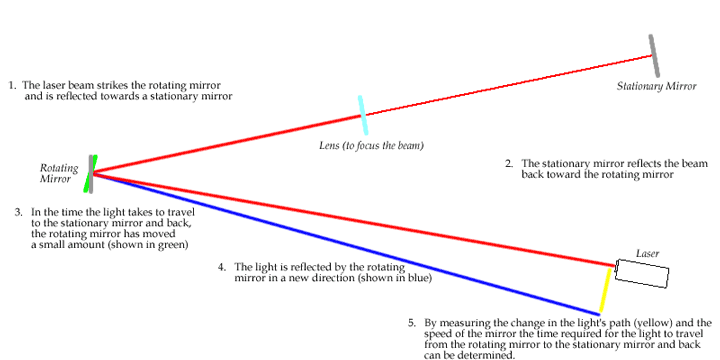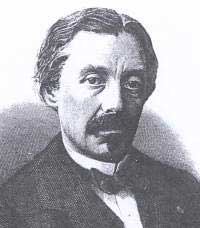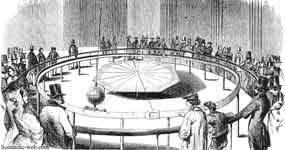.
Jean Bernard Léon Foucault
Jean Bernard Léon Foucault (18 September 1819–11 February 1868) was a French physicist best known for the invention of the Foucault pendulum, a device demonstrating the effect of the Earth's rotation. He also made an early measurement of the speed of light, invented the gyroscope, and discovered eddy currents.
Early years
Foucault was the son of a publisher at Paris, where he was born on September 18, 1819. After an education received chiefly at home, he studied medicine, which, however, he speedily abandoned for physical science. He first directed his attention to the improvement of L. J. M. Daguerre's photographic processes. For three years he was experimental assistant to Alfred Donné (1801–1878) in his course of lectures on microscopic anatomy.
With A. H. L. Fizeau he carried on a series of investigations on the intensity of the light of the sun, as compared with that of carbon in the arc lamp, and of lime in the flame of the oxyhydrogen blowpipe; on the interference of infrared radiation, and of light rays differing greatly in lengths of path; and on the chromatic polarization of light.
Middle years
In the 1840s, he contributed to the Comptes Rendus a description of an electromagnetic regulator for the electric arc lamp, and, in conjunction with his friend Jules Regnauld, a paper on binocular vision. In 1850, by the use of a revolving mirror similar to that used by Sir Charles Wheatstone for measuring the speed of electric currents, he was able to demonstrate the greater speed of light in air than in water, and to establish that the speed of light in different media is inversely as the refractive indices of the media (see Fizeau-Foucault Apparatus). From 1845, he wrote accounts of the weekly meetings of the Académie des sciences for an influential daily newspaper, the Journal des Débats. His frankness caused enmities which alienated him from many in the French academic establishment.
His demonstration in 1851 of the diurnal motion of the Earth by the rotation of the plane of oscillation of a freely suspended, long and heavy pendulum in the Panthéon in Paris, (http://www.bookmine.org) caused a sensation in both the learned and popular worlds, for it was the first dynamical proof of the Earth's rotation. In the following year he invented (and named) the gyroscope as a conceptually simpler experimental proof. In 1855 he received the Copley medal of the Royal Society for his 'very remarkable experimental researches'. Earlier in the same year he was made physicien (physicist) at the imperial observatory at Paris.
In September of 1855 he discovered that the force required for the rotation of a copper disc becomes greater when it is made to rotate with its rim between the poles of a magnet, the disc at the same time becoming heated by the eddy current or "Foucault currents" induced in the metal.

Diagram of a variant of Leon Foucault's speed of light experiment where a modern laser is the source of light. [Source]
Foucault invented in 1857 the polarizer which bears his name, and in the succeeding year devised a method of giving to the mirror of reflecting telescopes the shape of a spheroid or a paraboloid of revolution. With Wheatstone’s revolving mirror he in 1862 determined the speed of light to be 298,000 km/s (about 185,000 mi./s) —10,000 km/s less than that obtained by previous experimenters and only 0.6% off the currently accepted value.
Later years
He was created in that year a member of the Bureau des Longitudes and an officer of the Legion of Honour. In 1864 he was made a foreign member of the Royal Society of London, and next year a member of the mechanical section of the Institute. In 1865 appeared his papers on a modification of Watt's governor, upon which he had for some time been experimenting with a view to making its period of revolution constant, and on a new apparatus for regulating the electric light; and in the following year (Compt. Rend. lxiii.) he showed how, by the deposition of a transparently thin film of silver on the outer side of the object glass of a telescope, the sun could be viewed without injuring the eye. His chief scientific papers are to be found in the Comptes Rendus, 1847—1869.
Death and afterwards
Foucault died of what was probably a rapidly-developing case of multiple sclerosis on February 11, 1868 at Paris and was buried in the Cimetière de Montmartre.
Links
Dvorak, Rudolf, "Jean Bernard Léon Foucault(1850s) — an Applied Physicist".
Retrieved from "http://en.wikipedia.org/"
All text is available under the terms of the GNU Free Documentation License



